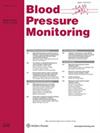Evaluation of cardiac electromechanics in patients with newly diagnosed hypertension.
IF 1.2
4区 医学
Q4 PERIPHERAL VASCULAR DISEASE
Blood Pressure Monitoring
Pub Date : 2023-12-01
Epub Date: 2023-08-03
DOI:10.1097/MBP.0000000000000667
引用次数: 0
Abstract
Objectives: This study aimed to investigate the relationship between subclinical left ventricular (LV) systolic dysfunction and ECG parameters in newly diagnosed hypertension patients. Methods: In this cross-sectional study, adults diagnosed with hypertension based on 24-h ambulatory blood pressure monitor recordings were included. The patients were classified into two groups based on the presence of subclinical LV systolic dysfunction according to LV global longitudinal strain (LVGLS). Findings were compared between the two groups. Results: A total of 244 patients (female, 55.7%) were included. Based on LVGLS, 82 (33.6%) patients had subclinical LV systolic dysfunction. The proportion of early repolarization pattern (ERP) on ECG was significantly higher in patients with subclinical LV systolic dysfunction than in patients with normal LV systolic function [24 (28.6%) vs. 8 (5%), P < 0.001]. PR and corrected QT intervals were also significantly longer in patients with subclinical LV systolic dysfunction than in patients with normal LV systolic function [median (interquartile range), 148 (132–158) vs. 141 (127–152), P = 0.036 and 443 (427–459) vs. 431 (411–455), P = 0.007, respectively]. According to multivariate regression analysis ERP, early (E) wave velocity/late (A) wave velocity (E/A), and LV mass index were independently associated with subclinical LV systolic dysfunction. Conclusion: In newly diagnosed hypertension patients, the ERP on admission ECG could be a sign of subclinical systolic dysfunction.新诊断高血压患者的心脏生物力学评价
本研究旨在探讨新诊断高血压患者亚临床左心室收缩功能障碍与心电图参数之间的关系。在这项横断面研究中,纳入了根据24小时动态血压监测记录诊断为高血压的成年人。根据左心室整体纵向应变(LVGLS),根据亚临床左心室收缩功能障碍的存在将患者分为两组。比较两组的研究结果。共纳入244名患者(女性,55.7%)。根据LVGLS,82名(33.6%)患者存在亚临床左心室收缩功能障碍。亚临床左心室收缩功能障碍患者心电图上早期复极模式(ERP)的比例显著高于左心室收缩功能正常的患者[24(28.6%)vs.8(5%),P < 亚临床左心室收缩功能障碍患者的PR和校正QT间期也明显长于左心室收缩功能正常患者[中位数(四分位间距),148(132-158)vs.141(127-152),P = 0.036和443(427–459)对431(411–455),P = 0.007)。根据多元回归分析ERP,早期(E)波速度/晚期(A)波速度(E/A)和左心室质量指数与亚临床左心室收缩功能障碍独立相关。在新诊断的高血压患者中,入院心电图上的ERP可能是亚临床收缩功能障碍的标志。
本文章由计算机程序翻译,如有差异,请以英文原文为准。
求助全文
约1分钟内获得全文
求助全文
来源期刊

Blood Pressure Monitoring
医学-外周血管病
CiteScore
2.00
自引率
7.70%
发文量
110
审稿时长
>12 weeks
期刊介绍:
Blood Pressure Monitoring is devoted to original research in blood pressure measurement and blood pressure variability. It includes device technology, analytical methodology of blood pressure over time and its variability, clinical trials - including, but not limited to, pharmacology - involving blood pressure monitoring, blood pressure reactivity, patient evaluation, and outcomes and effectiveness research.
This innovative journal contains papers dealing with all aspects of manual, automated, and ambulatory monitoring. Basic and clinical science papers are considered although the emphasis is on clinical medicine.
Submitted articles undergo a preliminary review by the editor. Some articles may be returned to authors without further consideration. Those being considered for publication will undergo further assessment and peer-review by the editors and those invited to do so from a reviewer pool.
 求助内容:
求助内容: 应助结果提醒方式:
应助结果提醒方式:


